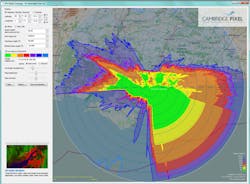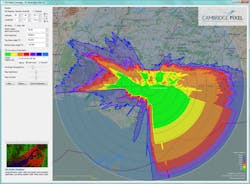For those seeking to learn more about the coverage offered by a particular radar system, a free software tool from Cambridge Pixel, the SPx Radar Coverage Tool, provides visualization of a radar system’s capabilities. It is a useful aid for finding the optimum location for a radar or other sensor working with line-of-sight detection.
The free-of-charge, Windows-based software is available for free download from the firm’s website. It is a time-saving tool for defense system integrators and security professionals seeking optimum coverage for a detection system. The proposed location of the radar may be entered directly as latitude and longitude, or the operator can simply click on a high-resolution map. The software calculates the visibility of targets at different heights based on the location and height of the radar.
“This is a really useful tool that our commercial security and defense customers have been asking for,” says David Johnson, CEO of Cambridge Pixel. “It is easy to use and provides a fast, interactive method of exploring the implications of different radar locations and heights.
“The Radar Coverage Tool will be helpful in a variety of radar surveillance applications,” he adds, “from coastal and air defense through to ground protection of military forward operating bases, large camps, observation posts and patrol bases where land features may provide blind spots in the radar coverage.”
About the Author
Jack Browne
Technical Contributor
Jack Browne, Technical Contributor, has worked in technical publishing for over 30 years. He managed the content and production of three technical journals while at the American Institute of Physics, including Medical Physics and the Journal of Vacuum Science & Technology. He has been a Publisher and Editor for Penton Media, started the firm’s Wireless Symposium & Exhibition trade show in 1993, and currently serves as Technical Contributor for that company's Microwaves & RF magazine. Browne, who holds a BS in Mathematics from City College of New York and BA degrees in English and Philosophy from Fordham University, is a member of the IEEE.


